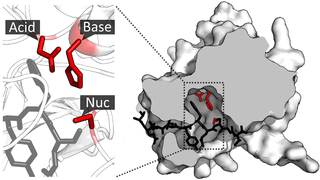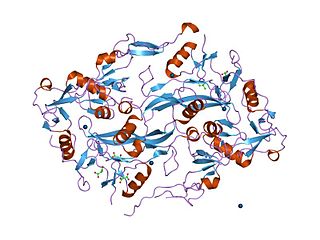Related Research Articles
In biology and biochemistry, protease inhibitors, or antiproteases, are molecules that inhibit the function of proteases. Many naturally occurring protease inhibitors are proteins.

A catalytic triad is a set of three coordinated amino acids that can be found in the active site of some enzymes. Catalytic triads are most commonly found in hydrolase and transferase enzymes. An acid-base-nucleophile triad is a common motif for generating a nucleophilic residue for covalent catalysis. The residues form a charge-relay network to polarise and activate the nucleophile, which attacks the substrate, forming a covalent intermediate which is then hydrolysed to release the product and regenerate free enzyme. The nucleophile is most commonly a serine or cysteine amino acid, but occasionally threonine or even selenocysteine. The 3D structure of the enzyme brings together the triad residues in a precise orientation, even though they may be far apart in the sequence.

Pepsin A is an enzyme. This enzyme catalyses the following chemical reaction
Membrane-bound transcription factor site-2 protease, also known as S2P endopeptidase or site-2 protease (S2P), is an enzyme encoded by the MBTPS2 gene which liberates the N-terminal fragment of sterol regulatory element-binding protein (SREBP) transcription factors from membranes. S2P cleaves the transmembrane domain of SREPB, making it a member of the class of intramembrane proteases.
Kexin is a prohormone-processing protease, specifically a yeast serine peptidase, found in the budding yeast. It catalyzes the cleavage of -Lys-Arg- and -Arg-Arg- bonds to process yeast alpha-factor pheromone and killer toxin precursors. The human homolog is PCSK4. It is a family of subtilisin-like peptidases. Even though there are a few prokaryote kexin-like peptidases, all kexins are eukaryotes. The enzyme is encoded by the yeast gene KEX2, and usually referred to in the scientific community as Kex2p. It shares structural similarities with the bacterial protease subtilisin. The first mammalian homologue of this protein to be identified was furin. In the mammal, kexin-like peptidases function in creating and regulating many differing proproteins.

Cathepsin L2 is a protein encoded in humans by the CTSV gene.
Cathepsin X is an enzyme. This enzyme catalyses the following chemical reaction

An Oligopeptidase is an enzyme that cleaves peptides but not proteins. This property is due to its structure: the active site of this enzyme is located at the end of a narrow cavity which can only be reached by peptides.

The Kazal domain is an evolutionary conserved protein domain usually indicative of serine protease inhibitors. However, kazal-like domains are also seen in the extracellular part of agrins, which are not known to be protease inhibitors.
Alpha-lytic endopeptidase or Alpha-lytic protease is an enzyme isolated from the myxobacterium Lysobacter enzymogenes. This enzyme is a serine protease that catalyses the breakage of peptide bonds using a hydrolysis chemical reaction. Alpha-lytic protease was named based on the observed cleavage specificity for the α position of the tetrapeptide component in gram-positive bacterial cell walls (alanine). Alpha-lytic protease is also capable of digesting elastin and other proteins.

Glutamyl endopeptidase is an extracellular bacterial serine protease of the glutamyl endopeptidase I family that was initially isolated from the Staphylococcus aureus strain V8. The protease is, hence, commonly referred to as "V8 protease", or alternatively SspA from its corresponding gene.
Lysyl endopeptidase is an enzyme. This enzyme catalyses the following chemical reaction
Picornain 2A is a protease enzyme. This enzyme catalyses selective cleavage of Tyr-Gly bond in picornavirus polyprotein.

The 3C-like protease (3CLpro) or main protease (Mpro), formally known as C30 endopeptidase or 3-chymotrypsin-like protease, is the main protease found in coronaviruses. It cleaves the coronavirus polyprotein at eleven conserved sites. It is a cysteine protease and a member of the PA clan of proteases. It has a cysteine-histidine catalytic dyad at its active site and cleaves a Gln–(Ser/Ala/Gly) peptide bond.
Rhizopuspepsin is an enzyme. This enzyme catalyses the following chemical reaction
Human endogenous retrovirus K endopeptidase is an enzyme derived from an endogenous retrovirus. This enzyme catalyses the following chemical reaction:
Bacillolysin is an enzyme. This enzyme catalyses the following chemical reaction
Leishmanolysin is an enzyme. This enzyme catalyses the following chemical reaction
Magnolysin is an enzyme. This enzyme catalyses the following chemical reaction

Proteasome endopeptidase complex is an enzyme. This enzyme catalyses the following chemical reaction
References
- ↑ Mallory PA, Travis J (February 1975). "Human pancreatic enzymes: purification and characterization of a nonelastolytic enzyme, protease E. resembling elastase". Biochemistry. 14 (4): 722–30. doi:10.1021/bi00675a012. PMID 234742.
- ↑ Shen WF, Fletcher TS, Largman C (June 1987). "Primary structure of human pancreatic protease E determined by sequence analysis of the cloned mRNA". Biochemistry. 26 (12): 3447–52. doi:10.1021/bi00386a030. PMID 3477287.